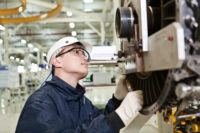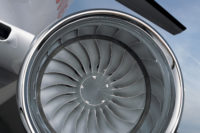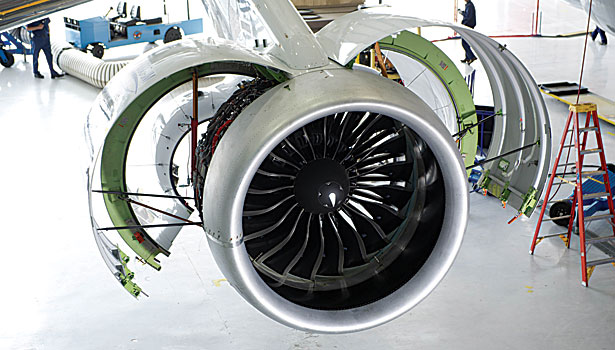Pratt & Whitney Rethinks Jet Engine Assembly
An innovative product requires a new production philosophy.

Pratt & Whitney is ramping up production on a cutting-edge product called the geared turbofan engine. Photo courtesy Pratt & Whitney

One of the biggest changes at Pratt & Whitney’s plants is a new horizontal assembly line. Photo courtesy Pratt & Whitney

The Airbus A320neo will use PurePower engines. Illustration courtesy Airbus

The Bombardier CSeries will use PurePower engines. Illustration courtesy Bombardier

The geared turbofan engine offers dramatic reductions in noise, emissions and fuel burn. Photo courtesy Pratt & Whitney

An overhead conveyor system provides ergonomic access to components on Pratt & Whitney’s new assembly lines. Photo courtesy Durr AG

The geared turbofan is the first commercial jet engine that uses gears to drive the fan. Illustration courtesy Pratt & Whitney

To ensure quality and boost productivity, Pratt & Whitney recently adopted production methods pioneered in the auto industry. Photo courtesy Pratt & Whitney

The PurePower product line will generate up to $5 billion in new revenue for Pratt & Whitney by the end of this decade. Photo courtesy Pratt & Whitney

Because each PurePower engine weighs up to 5,000 pounds, ergonomics and material handling are critical. Photo courtesy Pratt & Whitney










The bald eagle is a majestic symbol of power and freedom. It’s also the logo of one of America’s oldest aerospace manufacturers: Pratt & Whitney. The 89-year-old company is a leading producer of jet engines for many types of commercial and military aircraft.
Pratt & Whitney, a $15 billion division of United Technologies Corp., is in the process of ramping up production on a cutting-edge product called the geared turbofan engine. It offers dramatic reductions in noise, emissions and fuel burn.
The PurePower product line will generate up to $5 billion in new revenue by the end of this decade. To ensure quality and boost productivity, Pratt & Whitney recently invested millions of dollars in automation and adopted production methods pioneered in the auto industry.
The innovative engine is expected to greatly bolster demand for narrow-body, single-aisle commercial airliners in the decades ahead. Aircraft that accommodate less than 150 passengers are preferred by low-cost carriers that operate on short-haul routes with high traffic volumes. Airbus predicts the market will double between now and 2032, accounting for a $1.8 trillion segment of the aerospace industry.
To meet increasing demand, Airbus is ramping up production of its new A320neo. Its arch-rival, Boeing, is countering with the next-generation 737MAX. In addition, smaller aerospace manufacturers, such as Bombardier, Embraer and Mitsubishi, are in the process of rolling out new regional jets.
Fuel often represents the biggest expense for airlines, so the industry is hungry for more efficient engines. According to Teal Group, jet engine sales will total $500 billion in the next decade. Pratt & Whitney will account for a hefty portion of that market as it supplies Airbus, Bombardier, Embraer and Mitsubishi with next-generation products.
New Engine, New Attitude
Pratt & Whitney is pinning its future on a new family of jet engines such as the PurePower PW1100G-JM (the Airbus version) and the PW1500G (Bombardier’s version). The engines increase efficiency by spinning fan blades more slowly than traditional commercial airline engines. That results in an engine that’s 50 percent quieter and up to 16 percent more fuel efficient than traditional units.
The geared turbofan is the first commercial jet engine that uses gears to drive the fan. In conventional engines, the fan and turbine are directly connected and rotate at the same speed. By placing the gearbox between the fan and the engine, the fan only turns at one-third the speed of the turbine.
Pratt & Whitney engineers developed a state-of-the-art gear system that separates the engine fan from the low-pressure compressor and turbine, allowing each of the modules to operate at their optimum speeds. This enables both an increase in the diameter of the fan and the low-pressure compressor, and allows the turbine to operate at a high speed.
The increased efficiency also results in fewer engine stages and parts for lower weight and reduced maintenance costs. In addition, the PurePower PW1000G engine incorporates advances in aerodynamics and lightweight materials, such as the aerospace industry’s first use of aluminum fan blades.
“The geared turbofan engine will deliver double-digit improvements in fuel efficiency, environmental emissions and noise,” claims Dave Brantner, president of Pratt & Whitney Commercial Engines. “The PurePower engine family has more than 5,500 orders and commitments, including options.”
Pratt & Whitney will launch geared turbofan engines on five major aircraft platforms over the next four years. To meet unprecedented demand for the new Airbus A320neo (more than 3,000 aircraft are on order, with first delivery scheduled for next year), Pratt plans to implement a steady increase in production over the next three years until full production occurs in 2018. Bombardier plans to use a variant of the engine in its new CSeries aircraft, which will also enter service in 2015.
The next-generation engine will be assembled at Pratt & Whitney plants in Middletown, CT, Mirabel, QC, and West Palm Beach, FL. The company recently invested $63 million to expand its Florida operation, including a 97,000-square-foot-facility dedicated to assembling the PurePower PW1100G-JM. Initial production is scheduled to begin this month.
Bold Production Philosophy
The geared architecture has forced Pratt & Whitney’s engineers to rethink their production philosophy. “Our manufacturing strategy is based on balancing capability, capacity, flexibility and affordability,” says Danny Di Perna, vice president of engineering and operations.
“Our technology leadership and innovations on our next-generation product family have led to extraordinary success in the marketplace,” adds Lynn Gambill, chief engineer for manufacturing engineering and global services.
“This success has also led to an increase in our production volume not seen since the 1980s,” adds Gambill. “We have invested millions in our facilities to help support these production volumes. With all that’s been invested to position [us] for success, the company can’t allow single points of failure and must do what is necessary to succeed.”
New manufacturing techniques, innovation and standard work are critical to Pratt & Whitney’s success as the company begins producing its new engines. That’s why Pratt’s engineers turned to Detroit for inspiration.
“We teamed up with our colleagues at Sikorsky (another division of United Technologies),” says Steven Mongiat, business unit manager for modular assembly at Pratt & Whitney. “The lessons learned have helped out a lot. Among other things, they introduced us to automation suppliers and systems integrators in Detroit.”
As a result, Pratt & Whitney engineers have collaborated with companies such as Durr AG, Fanuc Robotics and RedViking. They also toured Ford Motor Co.’s Michigan Assembly Plant in Wayne, MI (recipient of ASSEMBLY’s 2012 Assembly Plant of the Year award) to gain insight.
“While volumes are not the same when assembling an automobile vs. a jet engine, the common denominator between the two industries is mistake proofing,” says Mongiat. “Common concerns include traceability and ergonomic zones associated with heights and distances.”
However, jet engines are much more complex than four-door sedans. “Among other things, they have more intricate heating and cooling systems,” Mongiat points out. “There’s a big difference between driving down a highway at 60 mph or flying at 32,000 feet.”
Advanced Automation
Pratt & Whitney prides itself on delivering “dependable engines.” It sees automation as a way to ensure that legacy continues during the aggressive ramp up over the next few years.
“Because our new products have higher volume and a long-term production run, it makes sense to invest in new production technology,” says Tom Mayes, general manager of engine centers. “It will give us some systems and robustness that help us achieve our deliveries. Automation allows us to address repeatability and quality issues, while helping operators be more productive.
“We have the capacity we need for the next 10 years, and we built that capacity with the ability to grow the product line,” adds Mayes. “With some minor modification, our new assembly floors can build almost any PurePower, whether it’s for Airbus, Bombardier or Embraer.”
Pratt & Whitney has invested in robots for coating and deburring applications that were previously done manually. “They provide consistency and address ergonomic concerns,” says Mongiat. “The robots can easily access areas that are difficult to reach by hand.” That’s important, because many of the components on the next-generation engines feature intricate geometries and tight tolerances.
By leveraging robotic systems that use vision and force-sensing capabilities, Pratt has reduced processing time and achieved up to 80 percent labor savings per engine part and $5 million annually in cost savings.
One of the biggest changes at Pratt & Whitney’s plants is a new horizontal assembly line. “Conventionally, all of the cores of jet engines are built up to the final installation of the fan and low-pressure turbine,” says Mayes. “That’s how every shop does it, from the high compressor and diffuser to the high turbine. In our new application, that whole core is built horizontally. We never go vertical.”
The horizontal rail production process is based on Durr’s FAStplant system. The modular assembly system is equipped with a low-maintenance overhead conveyor that provides ergonomic access to components.
In the past, Pratt & Whitney operators used a traditional floor-based engine assembly system that relied on pedestals that supported each assembly off of engine mounts. The new horizontal method is safer and more ergonomic.
“We use no ladders or pits, like in the past,” explains Mayes. “The geared turbofan lines are fully functional to go up or down so they can accommodate for anyone’s height, shape or capabilities. Assemblers can rotate engines 360 degrees, so they can always put hardware on in the right ergonomic position without bending, stooping or climbing. They also use zero-gravity manipulators and pressure-sensitive lift devices.”
Because each PurePower engine weighs up to 5,000 pounds, ergonomics and material handling are critical on the new lines. “We borrowed some ideas from Caterpillar, such as manual mobile systems that allow heavy subassemblies to ride between workstations on air skids,” says Mongiat. “Once we reach higher volumes, we may invest in automated guided vehicles.”
The new assembly lines feature visual work instructions and DC electric tools. Quality is the No. 1 initiative with the new approach.
“Our goal is 100 percent error-proofing,” explains Mongiat. “If there are any problems or issues with an engine downstream, we can audit the build process all the way back to the module assembly area and understand how we put it together.”
Traditionally, torque values were always manually input on Pratt & Whitney’s assembly lines. “We are now implementing DC electric fastening systems that feed back to our work instructions,” says Mongiat. “It’s poka-yoked so that operators cannot make any mistakes. If a specific torque value is not met or a bolt is missed, the assembler will not be able to progress any further.
“Dimensional data, balance information and other variables critical to our engines will no longer be manually entered as in the past,” adds Mongiat. “They are now provided directly from the production equipment to a database. As a result, we are doing more data tracking and trending vs. manual methods of feedback.”
Looking for a reprint of this article?
From high-res PDFs to custom plaques, order your copy today!




.jpg?height=200&t=1736673792&width=200)











